Street art
This article uses bare URLs, which may be threatened by link rot. (September 2021) |


Street art is unofficial and independent visual art created in public locations for public visibility. Street art is associated with the terms "independent art", "post-graffiti", "neo-graffiti", and guerrilla art.[1]
Background[]
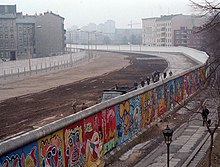 Germany's Berlin Wall (shown 1986) was a target of artists during its existence (1961–1989) |
 "Independent public art" such as a balance sculpture can be installed in remote areas, and may be short-lived.[2] |
Street art is a form of artwork that is displayed in public on surrounding buildings, on streets, trains, and on other publicly viewed surfaces. Many instances come in the form of guerrilla art, which is intended to make a personal statement about the society that the artist lives within. The work has moved from the beginnings of graffiti and vandalism to new modes where artists work to bring messages, or just beauty, to an audience.[3]
Some artists may use "smart vandalism" as a way to raise awareness of social and political issues,[4] whereas other artists use urban space as an opportunity to display personal artwork. Artists may also appreciate the challenges and risks that are associated with installing illicit artwork in public places. A common motive is that creating art in a format that utilizes public space allows artists who may otherwise feel disenfranchised to reach a much broader audience than other styles or galleries would allow.
Whereas traditional graffiti artists have primarily used spray paint to produce their work, "street art" can encompass other media, such as LED art, mosaic tiling, stencil art, sticker art, reverse graffiti, "Lock On" sculptures, wheatpasting, woodblocking, yarn bombing, and rock balancing.[5] New media forms such as video projections onto large city buildings are an increasingly popular tool for street artists—and the availability of cheap hardware and software allows such artwork to become competitive with corporate advertisements. Artists are thus able to create art from their personal computers for free, which competes with companies' profits.[6]
Origins[]
Slogans of protest and political or social commentary graffiti on walls are the precursor to modern graffiti and street art, and continue as one aspect of the genre. Street art in the form of text or simple iconic graphics of corporate icons can become well-known yet enigmatic symbols of an area or an era.[7] Some credit the Kilroy Was Here graffiti of the World War II era as one such early example; a simple line-drawing of a long-nosed man peering from behind a ledge. Author Charles Panati indirectly touched upon the general appeal of street art in his description of the "Kilroy" graffiti as "outrageous not for what it said, but where it turned up".[8] Much of what can now be defined as modern street art has well-documented origins dating from New York City's graffiti boom, with its infancy in the 1960s, maturation in the 1970s, and peaking with the spray-painted full-car subway train murals of the 1980s centered in the Bronx.
As the 1980s progressed, a shift occurred from text-based works of early in the decade to visually conceptual street art such as Hambleton's shadow figures.[9] This period coincides with Keith Haring's subway advertisement subversions and Jean-Michel Basquiat's SAMO tags. What is now recognized as "street art" had yet to become a realistic career consideration, and offshoots such as stencil graffiti were in their infancy. Wheatpasted poster art used to promote bands and the clubs where they performed evolved into actual artwork or copy-art and became a common sight during the 1980s in cities worldwide.[citation needed] The group working collectively as AVANT was also active in New York during this period.[10] Punk rock music's subversive ideologies were also instrumental to street art's evolution as an art form during the 1980s. Some of the anti-museum mentality can be attributed to the ideology of Marinetti who in 1909 wrote the "Manifesto of Futurism" with a quote that reads, "we will destroy all the museums."[11] Many street artists claim we do not live in a museum so art should be in public with no tickets.[11]
Early iconic works[]
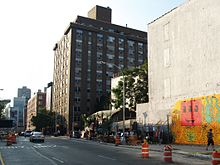
The northwest wall of the intersection at Houston Street and the Bowery in New York City has been a target of artists since the 1970s. The site, now sometimes referred to as the Bowery Mural, originated as a derelict wall that graffiti artists used freely. Keith Haring once commandeered the wall for his use in 1982. After Haring, a stream of well-known street artists followed, until the wall had gradually taken on prestigious status. By 2008, the wall became privately managed and made available to artists by commission or invitation only.[citation needed]
A series of murals by René Moncada began appearing on the streets of SoHo in the late 1970s emblazoned with the words I AM THE BEST ARTIST. René has described the murals as a thumb in the nose to the art community he felt he'd helped pioneer but by which he later felt ignored by.[7][12] Recognized as an early act of "art provocation",[13] they were a topic of conversation and debate at the time, and related legal conflicts raised discussion about intellectual property, artist's rights, and the First Amendment.[14][15][16][17] The ubiquitous murals also became a popular backdrop to photographs taken by tourists and art students, and for advertising layouts and Hollywood films.[18][19][20] IATBA murals were often defaced, only to be repainted by René.[13][21]

René Moncada: I AM THE BEST ARTIST, New York (1986)
Commercial crossover[]
Some street artists have earned international attention for their work and have made a full transition from street art into the mainstream art world — some while continuing to produce art on the streets. Keith Haring was among the earliest wave of street artists in the 1980s to do so. Traditional graffiti and street art motifs have also increasingly been incorporated into mainstream advertising, with many instances of artists contracted to work as graphic designers for corporations. Graffiti artist Haze has provided font and graphic designs for music acts such as the Beastie Boys and Public Enemy. Shepard Fairey's street posters of then-presidential candidate Barack Obama were reworked by a special commission for use in the presidential campaign. A version of the artwork also appeared on the cover of Time magazine. It is also not uncommon for street artists to start their own merchandising lines.[citation needed]
Street art has received artistic recognition with the high-profile status of Banksy and other artists. This has led street art to become one of the 'sights to see' in many European cities. Some artists now provide tours of local street art and can share their knowledge, explaining the ideas behind many works, the reasons for tagging, and the messages portrayed in a lot of graffiti work. Berlin, London, Paris, Hamburg and other cities all have popular street art tours running all year round. In London alone there are supposedly ten different graffiti tours available for tourists.[22] Many of these organizations, such as Alternative London,[23] ParisStreetArt,[24] AlternativeBerlin,[25] pride themselves on working with local artists, so visitors can get an authentic experience and not just a rehearsed script.
Many of these guides are painters, fine-art graduates and other creative professionals that have found the medium of street art as a way to exhibit their work. With this commercial angle, they can let people into the world of street art and give them more of an understanding of where it comes from. It has been argued that this growing popularity of street art has made it a factor in gentrification.[26]
Legality and ethics[]
Street art can have legal problems. The parties involved can include the artist, the city or municipal government, the intended recipient, and the owner of the structure or the medium where the work was displayed. One example is a case in 2014 in Bristol, United Kingdom, which illustrates the legal, moral, and ethical questions that can occur. The Mobile Lovers by Banksy was painted on plywood on a public doorway, then cut out by a citizen who in turn was going to sell the piece to garner funds for a boys' club. The city government in turn confiscated the artwork and placed it in a museum. Banksy, hearing of the conundrum, then bequeathed it to the original citizen, thinking his intentions were genuine. In this case, as in others, the controversy of ownership and public property, as well as the issues of trespassing and vandalism, are issues to be resolved legally.[27]
Copyright[]
Under US law, works of street art should be able to find copyright protection as long as they are legally installed and can fulfil two additional conditions; originality in the work, and that it is fixed in a tangible medium.[28] This copyright would then survive for the lifespan of the artist plus 70 years.[29] In case there is a collaboration between two artists, both would hold joint ownership in the copyright.[30] Street artists also hold moral rights in their work, independent of economic rights arising from copyright. These include the right to integrity and the right to attribution.[31] Recently, street art has started to gain recognition among art critics, and some major companies have found themselves in trouble for using this art without permission for advertising. In such a case, H&M, a fast-fashion retailer used street art by Jason "Revok" Williams in an advertisement series.[32] In response to Williams’ ‘Cease and Desist’ notice, however, H&M filed a lawsuit, alleging that since the work is a "product of criminal conduct", it cannot be protected by copyright. This view has been taken earlier too, in the cases of Villa v. Pearson Education[33] and Moschino and Jeremy Tierney.[34] In all three cases, before the judge could make a ruling on the issue of the illegality of the art, settlements were reached.[35] These companies typically settle out of court to avoid costly, time-consuming litigation.
When it comes to the question of the destruction of street art, the US has applied the Visual Artists Right Act (VARA)[36] to introduce moral rights into copyright law. In English v. BFC & R East 11th Street LLC and Pollara v. Seymour, it was held that this Act was inapplicable to works of art placed illicitly. A distinction was also made between the removable and nonremovable works, indicating that if a work can be removed trivially, it cannot be destroyed, irrespective of its legal status.[37] Another important factor considered by the court in the latter case was whether the artwork was "of a recognized stature".[35]
In a case where a group of artists was awarded $6.7 million, the judge held that the art was not made without permission of the owner of the building, and that an important factor was that the demolition was done ahead of the intended date, indicating willful thought.[38]
Street art, guerrilla art, and graffiti[]
Graffiti is characteristically made up of written words that are meant to represent a group or community in a covert way and in plain sight. The telltale sign of street art is that it usually includes images, illustrations, or symbols that are meant to convey a message.[39] While both works are meant to represent or tell a message to viewers, one difference between the two comes in the specific viewers that it is meant for. One trait of street art that has helped to bring it to positive light in the public eye is that the messages shown are usually made to be understandable to all.[39]
While both of these types of art have many differences, there are more similarities than their origins. Both graffiti and street art are works of art that are created with the same intent. Most artists, whether they are working anonymously, creating an intentionally incomprehensible message, or fighting for some greater cause are working with the same ambitions for popularity, recognition, and the public display or outpouring of their personal thoughts, feelings, and/or passions.[39]
The term street art is described in many different ways, one of which is the term "guerrilla art." Both terms describe these public works that are placed with meaning and intent. They can be done anonymously for works that are created to confront taboo issues that will result in a backlash, or under the name of a well-known artist. With any terminology, these works of art are created as a primary way to express the artist's thoughts on many topics and issues.[40]
As with graffiti, a defining trait or feature of street art is that it is created on or in a public area without or against the permission of the owner.[41] A main distinction between the two comes in the second trait of street art or guerrilla art, where it is made to represent and display a purposefully uncompliant act that is meant to challenge its surrounding environment.[41] This challenge can be granular, focusing on issues within the community or broadly sweeping, addressing global issues on a public stage.
This is how the term "guerrilla art" was associated with this type of work and behavior. The word ties back to guerrilla warfare in history where attacks are made wildly, without control, and with no rules of engagement. This type of warfare was dramatically different from the previously formal and traditional fighting that went on in wars normally. When used in the context of street art, the term guerilla art is meant to give a nod to the artist's uncontrolled, unexpected, and often unnamed attack on societal structure or norms.[42]
Is it sufficient to place art in the street to make street art? Nicholas Riggle looks more critically at the border between graffiti and street art and states the "an artwork is street art if - and only if - its material use of the street is internal to its meaning"(The Journal of Aesthetics and Art Criticism, 68:3, summer 2010). The street is not a blank canvas for the street artist. It has a character, a use, a history, a texture, a shape. Street art, and broader urban art, transforms the street or opens the dialogue. Armstrong states Graffiti is identified as an aesthetic occupation of spaces, whereas urban street art repurposes them. (The Contested Gallery: Street Art, Ethnography and the Search for Urban Understandings, AmeriQuest Vol. 2 nr. 1, 2005)
Guerilla sculpture[]
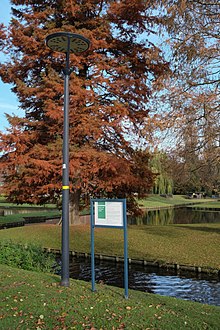
Guerilla sculpture is the placement of sculptures in street settings without official approval; it developed from street art in England in the late 20th century.[42] In addition to the nontraditional setting of the works of art involved, there are also many different techniques used in the creation of this artwork. The artists tend to work illegally and in secrecy to create and place these works in the dark of night, cloaked in mystery regarding their origins and creators. The sculptures are used to express the artist's views and to reach an audience that would not otherwise be reached through more traditional methods of displaying one's work to the public. In performing these acts of artistic expression, they are not working to gain acceptance or love of the people that they reach, but at times may even anger those who view their work.[42]
An example is the overnight appearance of an unsanctioned sculpture of Edward Snowden onto a column in Fort Greene Park in New York City.[42] In other cases, the sculptures integrate two-dimensional backdrops with a three-dimensional component, such as one by Banksy titled Spy Booth (2014). The backdrop was painted on a wall in Cheltenham, England and featured Cold-War spy characters adorned in trench coats and fedoras, with spy accoutrements, microphones, and reel-to-reel tape decks. These characters appeared to be tapping into a broken telephone booth.[42]
On the 15th July 2020, a month after the statue of Edward Colston was pulled down during Black Lives Matter protests in Bristol, Artist Marc Quinn used the empty plinth to display his sculpture ‘A Surge of Power (Jen Reid)’. The life-sized piece, created from black resin and steel,[43] was inspired by a picture of protester Jen Reid, raising her fist during the Bristol protest that subsequently went viral and caught the attention of Quinn.The statue was removed by Bristol City Council on 16 July 2020.[44]
A deviation from the unsanctioned street sculpture is "institutionalized guerilla sculpture", which is sanctioned by civic authorities and can be commercialized. One such artist from the Netherlands is Florentijn Hofman, who in 2007 created Rubber Duck, a colossal rendition of the childhood tub-toy. The Guardians of Time guerrilla dOCUMENTA are social sculptures by Manfred Kielnhofer.
Public acceptance[]
Although street art may be ubiquitous around the world, the popularity of its artistic expression is relatively recent. Street art has undergone a major transformation in public opinion to become socially accepted and respected in some public places.[41] Even with this degree of acceptance, defacing private or public property with any and all message, whether it is considered art or not, is still widely illegal.[41]
In the beginning, graffiti was the only form of street art that there was and it was widely considered to be a delinquent act of territorial marking and crude messaging. Initially, there were very clear divisions between the work of a street artist and the act of tagging a public or private property, but in recent years where the artists are treading the line between the two, this line has become increasingly blurred.[41] Those who truly appreciate the work of famed street artists or street works of art are in acceptance of the fact that this art would not be the same without the medium being the street. The works are subject to whatever change or destruction may come because since they are created on public or private surfaces which are neither owned by the artist or permitted to be worked on by the property owners. This acceptance of the potential impermanence of the works of art and the public placement of the uncondoned works are what contribute to the meaning of the piece and therefore, what helps the growth of street art popularity.[41]
Free art movement[]
The free art movement is the practice of artists leaving art in public places as street art, as well as being free for the public to remove and keep. The artwork is usually tagged with a notice stating it is free art, and either with the artist's name or left anonymously. The movement was reinvigorated by British artist coining the term "Free Art Fridays" and actively participating in the movement, which has since spread internationally.[45] Clues to the location of artworks are sometimes left on social media to combine treasure hunting with art.[46]
The movement is distinct from the free culture movement as the artist retains full copyright for the work.
Beautification movement[]
Given the various benefits and high return on investment[47] street art provides to businesses, schools, neighborhoods, and cities, a movement of using street art as a tool to create safer, brighter, more colorful, and inspiring communities has also been recognized. Organizations like Beautify Earth have pioneered cities to leverage these benefits to create widespread beauty where it would be otherwise empty or dilapidated public wall space.[48]
North America[]
New York City attracts artists from around the world.[49] In Manhattan, "post-graffiti" street art grew in the 1980s from the then largely vacant neighborhoods of SoHo and the Lower East Side. The Chelsea art district became another locale, with area galleries also hosting formal exhibitions of street artist's work. In Brooklyn, the Williamsburg and Dumbo neighborhoods — especially near the waterfront — are recognized street art sites.[50] New York City's unofficial Mural District is in Brooklyn's Bushwick neighborhood, with curatorial gatekeeping by a non-profit organization called The Bushwick Collective.
Chicago has many forms of street art emerging but some of the most popular artists that can be seen everywhere in Chicago is Sentrock, Jc Rivera (The Bear Champ), and Hebru Brantley.
Programs in the Pennsylvania cities of Philadelphia and Pittsburgh provide funding to agencies who employ street artists to decorate city walls. The Mural Arts Program established in 1984 has helped Philadelphia earn praise as the "City of Murals". The project was initiated to encourage graffiti artists toward a more constructive use of their talents. Murals backed by The Sprout Fund in Pittsburgh were named the "Best Public Art" by the Pittsburgh City Paper in 2006.[51][52]
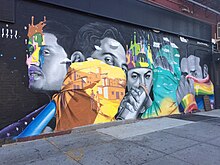


Street art in Atlanta centers on the Old Fourth Ward and Reynoldstown neighborhoods, the Krog Street Tunnel, and along the 22-mile BeltLine railway corridor which circles the inner city. Atlanta established a Graffiti Task Force in 2011. Although the city selected a number of murals that would not be targeted by the task force, the selection process overlooked street art of the popular Krug Street Tunnel site. Art created in conjunction with the Living Walls street art conference, which Atlanta hosts annually, was spared. Some actions were taken by the unit, including arrests of artists deemed vandals, caused community opposition; some considered the city's efforts as "misdirected" or "futile".[53][54] After being sued by a group of artists in 2017 the city of Atlanta agreed not to enforce an ordinance requiring artists to obtain city approval for murals on private property.[55] Images and locations of over 200 works of Atlanta street art can be found on the Atlanta Street Art Map.[56]
Sarasota, Florida, hosts an annual street art event, the Sarasota Chalk Festival, founded in 2007. An independent offshoot known as Going Vertical sponsors works by street artists, but some have been removed as controversial.[57][58]
Los Angeles's Arts District is known for its high concentration street murals.[59] The neighborhood of Hollywood and streets such as Sunset Boulevard, La Brea, Beverly Boulevard, La Cienega, and Melrose Avenue are among other key locations.[60] LAB ART Los Angeles, opened in 2011, devotes its 6,500 square feet of gallery space to street art. Artwork by locals such as Alec Monopoly, Annie Preece, Smear and Morley are among the collection.
San Francisco's Mission District has densely packed street art along Mission Street, and along both Clarion and Balmy Alleys.[61] Streets of Hayes Valley, SoMa, Bayview-Hunters Point and the Tenderloin have also become known for street art.[62] San Diego's East Village, Little Italy, North Park, and South Park neighborhoods contain street artwork of VHILS, Shepard Fairey, Tavar Zawacki a.k.a. ABOVE, Space Invader, Os Gêmeos, among others. Murals by various Mexican artists can be seen at Chicano Park in the Barrio Logan neighborhood.
Montreal (Canada) With over 80 murals and counting since the foundation of MURAL Festival in 2013, the annual street art festival contributed to creating Le Plateau-Mont-Royal as an epicenter for urban arts. Villeray, Downtown Montreal Le Sud-Ouest, Hochelaga-Maisonneuve, and multiple art districts also continue to broaden the street art circuit within the Island of Montreal.[citation needed] The Under Pressure annual graffiti festival, the largest of its kind in North America, celebrated its 25th anniversary in 2021.[63]
Toronto (Canada) has a significant graffiti scene.[64]
Calgary (Canada) While historically having a smaller graffiti street art scene, the city recently started the Beltline Urban Mural Project (BUMP) with artists from all over the world creating large murals in the city center.[65]
Richmond, Virginia has over 100 murals created by artists, many of whom are alumni of Virginia Commonwealth University's School of the Arts or current students there. Some of the murals are privately commissioned by individuals and businesses, some are created by solo street artists, and some are collaborative group fund-raising projects.[66]
Denver street artists have been busy brightening (and enlightening) the urban landscape for decades by making canvases of the city's alleyways, building exteriors, warehouses, garage doors and storefronts.[67] The city of Denver has a whole area called the River North Art District (RiNo) that is dedicated to the work of local creative artists. Most artists in the RiNo district are commissioned by the local business owners who want to give their buildings colorful imagery.[citation needed]
Mexico
The manifestations of street art in Mexico began in the late 80s in Mexico City, inside multifamily buildings in the north of the city and also in the subway. Since then, urban art and graffiti have formed an essential part of cultural identity in the different city halls of the metropolis. Currently, some different associations and groups are dedicated to the creation and search of spaces for urban art in Mexico City and throughout the country. Even several artists, both national and foreign or emerging and consolidated, have taken their art to the Latin American country.

There are also media, such as All City Canvas,[68] specialized in the dissemination of urban art in Mexico, Latin America and the rest of the world. In that way, it has been possible to create a universal language around this artistic manifestation. Even in 2012, All City Canvas was the first organization to create a street art festival in Mexico that sought to join international efforts and create urban art for a week in Mexico City. In recent years, they have produced several murals in collaboration with talented artists such as Vhils, It's a Living and Bier in Brood,[69] as part of the All City Canvas Global Series[70] in some cities in Mexico and the United States. The objective of the initiative is to create an impact on society through a large-scale piece of art.
South America[]
Buenos Aires has developed a reputation for its large scale murals and artworks in many subway stations and public spaces. The first graffiti artists started painting in the street in the Argentine capital in the mid-1990s after visiting other countries in Europe and South America. One of the first recognized street artists in Argentina is Alfredo Segatori, nicknamed 'Pelado', who began painting in 1994 and holds the record for the largest mural in Argentina[71] measuring more than 2000 square meters.
An abundance of buildings slated for demolition provides blank canvases to a multitude of artists, and the authorities cannot keep up with removing artists' output. "Population density" and "urban anxiety" are common motifs expressed by "Grafiteiros" in their street art and pichação, rune-like black graffiti, said to convey feelings of class conflict.
Influential Brazilian street artists include Claudio Ethos, Os Gêmeos, Vitche, Onesto, and Herbert Baglione.[72][73]
Bogotá has a lot of walls dedicated to street art and a powerful artistic movement. The tourist can appreciate several wall performances around 26 street (), and the historical neighborhood La Candelaria.
Recently, Bogotá's street art suffered persecution by local and municipal governments that erase works in several public and private walls arguing vandalic acts, private property damage and visual contamination.[74]
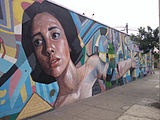
Graffiti in Lima, Peru (2014)

Work of Brazilian artists Os Gêmeos, in Lisbon, Portugal (2011)
Europe[]

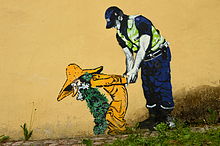
London has become one of the most pro-graffiti cities in the world. Although officially condemned and heavily enforced, street art has a huge following and in many ways is embraced by the public, for example, Stik's stick figures.[76] Dulwich Outdoor Gallery, in collaboration with Street Art London, is an outdoor "gallery" of street art in Dulwich, southeast London, with works based on traditional paintings in Dulwich Picture Gallery.[77]
Bristol has a prominent street art scene, due in part to the success of Banksy,[78] with many large and colorful murals dominating areas of the city.
Ostend, Belgium, Belgium hosts an international street art festival. In 2018, US art magazine Juxtapoz described The Crystal Ship as “an art festival that is quickly becoming one of the major annual street art events in the world”. Today, it is just that. Having seen the light of day in 2016, every year, The Crystal Ship paints the town of Ostend red (and blue, and green, and yellow, and quite possibly every other colour you can imagine) by inviting a host of acclaimed street artists to get inspired by its people, landscape, and heritage. Curator Bjorn Van Poucke is the driving force behind this street art walhalla where the work of artists like Axel Void (USA), Paola Delfín (Mexico), Escif (ES), Miss Van (FR), Sebas Velasco (ES), Elian (AR) and Wasted Rita (PT) transform the city.
Poland has artists like Sainer and Bezt known for painting huge murals on buildings and walls.[79]
Paris, France has an active street art scene that is home to artists such as Space Invader, Jef Aérosol, and Zevs. Some connect the origins of street art in France to Lettrism of the 1940s and Situationist slogans painted on the walls of Paris starting in the late 1950s. Nouveau realists of the 1960s, including Jacques de la Villeglé, Yves Klein and Arman interacted with public spaces but, like pop art, kept the traditional studio-gallery relationship. The 1962 street installation Rideau de Fer (Iron Curtain) by Christo and Jeanne-Claude is cited as an early example of unsanctioned street art. In the 1970s, the site-specific work of Daniel Buren appeared in the Paris subway. Blek le Rat and the Figuration Libre movement became active in the 1980s.[citation needed][80] The 13 arrondissement is actively promoting street art through the Street Art 13 project. That includes two remarkable frescos by D*Face from London: "Love will not tear us apart" and "Turncoat".[81] Between October 2014 and March 2015, Fondation EDF hosted Jérôme Catz's exhibition "#STREET ART, L’INNOVATION AU CŒUR D’UN MOUVEMENT", which featured new technologies integrated with pieces by artists including Shepard Fairey, JR, Zevz, and Mark Jenkins. The exhibition became the second most-visited exhibit at EDF since it opened in 1990.[82] Street artist John Hamon's work primarily involves projecting or pasting a poster of his photograph above his name on buildings and monuments across the city.[83]
Street art on the Berlin Wall was continuous during the time Germany was divided, but street art in Berlin continued to thrive even after reunification and is home to street artists such as Thierry Noir Tavar Zawacki a.k.a. ABOVE and . Post-communism, cheap rents, and ramshackle buildings gave rise to street art in areas such as Mitte, Prenzlauer Berg, Kreuzberg, and Friedrichshain.[citation needed] In 2016, initiated an urban artwork in the name of , in which several famous artists participated.[84]
The second biggest city in Estonia, Tartu, has been called the Estonian street art capital.[85] While Tallinn has been against graffiti, Tartu is known for the street art festival Stencibility and for being home to a wide range of works from various artists.[86]
The street art scene in Greece has been active since the late 1980s but gained momentum in Athens leading up to the country's 2011 financial crisis, with a number of artists raising voices of resistance, creating allegorical works and social commentary in the historic city center and Exarhia district. The New York Times published a story about the crisis in relation to street art and art in general.[87] Street art by Bleepsgr, whose work has been categorized as "artivism", can be found in neighborhoods such as Psiri.
In Spain Madrid and Barcelona represent the most graffiti populated cities, while Valencia, Zaragoza and Málaga also have a street art scene.[88]

Italy has been very active in street art since the end of the 1990s; some of the most famous street artists include BLU, 108, and Sten Lex.[89]
Street Art in Amsterdam (Netherlands) has a long history. In the mid-1960s, the counterculture movement named the provos already used the street as a canvas. Member Robert Jasper Grootveld wrote things like “Klaas komt” (English: "Klaas is Coming!”) throughout the whole city. At the end of the 1970s, young artists from the punk culture wrote on the decayed city. Well-known artists from this ‘No Future-generation’ are Dr. Rat and Hugo Kaagman, the stencil art pioneer who made his first stencil back in 1978.[90][91] Yaki Kornblit brought New York graffiti artists like Blade, Dondi, Futura 2000 and Rammellzee to Amsterdam to exhibit in his gallery in the early 80s. This inspired the youth, from which a new generation style writers emerged that was later recorded in the documentary Kroonjuwelen (2006). Names as Delta, Shoe, Jaz, Cat22, High, Again and Rhyme left their mark on the city. In the early 1990s, Amsterdam became the epicenter of the graffiti movement, with a focus on its Metro system, bringing writers such as Mickey, Zedz and Yalt to the capital of the Netherlands.[92] Figurative street art became more and more common in the streets around the turn of the century. Morcky, Wayne Horse, The London Police en Laser 3.14 communicated through their work on the street.
The city of Bergen is looked upon as the street art capital of Norway.[93] British street artist Banksy visited the city in 2000 and inspired many to take their art to the streets.[94] Dolk is among local street artists in Bergen.[95][96] His art can be seen around the city. Bergen's city council in 2009 chose to preserve one of Dolk's works with protective glass.[97]
In 2011, the city council launched a plan of action for street art from 2011–2015 to ensure that "Bergen will lead the fashion for street art as an expression both in Norway and Scandinavia".[98]
The city of Stavanger is host to the annual NuArt Festival, an event dedicated to promoting street art; the festival is one of the oldest curated "street art" festivals in the world. Nuart Plus is an associated industry and academic symposium dedicated to street art. The event takes place each September. Oslo, by contrast, traditionally has a zero tolerance policy against graffiti and street art, but the sanctioned NuArt RAD project is changing that.[99]

Street art came to Sweden in the 1990s and has since become the most popular way to establish art in public space. The 2007 book "Street Art Stockholm", by Benke Carlsson, documents street art in the country's capital.[100]
The street art scene of Finland had its growth spurt from the 1980s onwards until in 1998 the city of Helsinki began a ten-year zero-tolerance policy which made all forms of street art illegal, punishable with high fines, and enforced through private security contractors. The policy ended in 2008, after which legal walls and art collectives have been established.[citation needed]
Wheatpaste and stencil graffiti art in Denmark increased rapidly after visits from Faile, Banksy, Ben Eine, and Shepard Fairey between 2002 and 2004, especially in urban areas of Copenhagen such as Nørrebro and Vesterbro.[101] Copenhagen is home of TEJN, the artist credited with introducing the Lock On street art genre.
The street art scene in Switzerland saw the artist Harald Nägeli in the late 1970s.[102] Activity from the nineties on included artists like Toast[103] and NEVERCREW.
Since the collapse of communism in 1989, street art became prevalent in Poland throughout the 1990s. In the city of Łódź a permanent city exhibition was financed in 2011, under the patronage of Mayor Hanna Zdanowska, called "Urban Forms Gallery".[104] The exhibition included work from some of Poland's elite street artists as well as globally known artists. Despite being mostly accepted by the public, with authorities occasionally allowing artists licenses to decorate public places, other properties are still illegally targeted by artists. Warsaw and Gdańsk are other Polish cities with a vibrant street art culture.[105]
A monument in Bulgaria depicting Soviet Army soldiers was targeted by anonymous street artists in June 2011. The soldiers of the monument, located in Sofia, were embellished to portray Ronald McDonald, Santa Claus, Superman, and others. The monument existed in that condition for several days before being cleaned. Some citizens were in favor of allowing the embellishments to remain.[citation needed]
Moscow has increasingly become a hub for Russian graffiti artists as well as international visitors. The Street Kit Gallery, opened in 2008, is dedicated to street art and organizes events in galleries, pop-up spaces and on the streets of the city. The 2009 Moscow International Biennale for Young Art included a section for street art. Active artists include Make, RUS, and Kiev-based Interesni Kazki (also active in Miami and Los Angeles).[106] Britain's BBC network highlighted the artwork of Moscow street artist Pavel 183 in 2012.[107][108]
The dissolution of the Soviet Union left Georgia with tantalizing urban space for the development of street art. Although it is a relatively new trend in Georgia, the popularity of street art is growing rapidly. The majority of Georgian street artists are concentrated in Tbilisi. Street art serves as a strong tool among young artists to protest against the many controversial issues in the social and political life in Georgia and thus gets considerable attention in society. Influential artists include Gagosh, TamOonz, and Dr.Love.[108][109][110]
Sarajevo has become a major hub for street art in Southeastern Europe. It hosts the Sarajevo Street Art Festival and the acclaimed 3D street art festival, Beton Fest. The former is held in July of every year and lasts for three days. Each year's edition is made up of numerous street performances, the creation of a new street arts bohemian quarter in the city, concerts, the painting of large murals and the showcasing of other creative art forms. The latter is the only 3D street art festival in Southeastern Europe[111] and has hosted many renowned street artists such as Vera Bugatti,[112] Giovanna la Pietra,[113] Tony Cuboliquido,[114] Manuel Bastante[115] and others.

Street art by WATTTS in Paris

Painting in the Global Tradition by Ces53, a Dutch street artist

Street art in Sesimbra, Portugal
Graphic-Domain in Heidelberg by Nicola Pragera
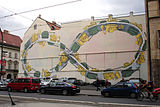
Mural by BLU, Gaza Strip, Prague

Graffiti in Shoreditch, London by Stik
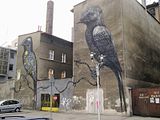
Urban art in Katowice, Poland

Street art in the old city of Prizren, Kosovo

Mural painting "Propagating machine" realized by Nevercrew in Mannheim, Germany in 2017.

Work by Bleepsgr in Athens

Lie Lie Land by female street artist Bambi in Islington, London.
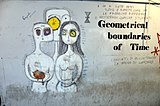
"Geometrical boundaries of Time", street art in Tbilisi.

Paste-up of El Bocho in Hamburg (Germany)

Asia[]
South Korea[]
In South Korea's second-largest city, Busan, German painter Hendrik Beikirch created a mural over 70 metres (230 ft) high, considered Asia's tallest at the time of its creation in August 2012. The monochromatic mural portrays a fisherman.[116] It was organized by Public Delivery.[117]
United Arab Emirates[]
In United Arab Emirates' largest city, Dubai, several famous painters created urban mural artwork on the buildings, which was initiated by and named it .[118][119]
India[]
In India, street art is hugely popular. Many of the film and TV series promotional materials were created by street painters/artists. Currently, digital art is replacing hand painted posters. From 1960 to the 1990s, the street posters worked well and impressed audiences. In the 1990s the hand painted posters started to be replaced by flex banners outside theatres. After the 2000s, the popularity of street posters started to decline, being replaced by digitally printed posters. Street art painting and street art drawing sketch has since declined in India due to the replacement by digital posters.
Oceania[]
Australia[]
There is street art in major cities as well as regional towns in Australia.[120]

Melbourne is home to one of the world's most active and diverse street art cultures and is home to pioneers in the stencil medium. Street artists such as Blek le Rat and Banksy often exhibited works on Melbourne's streets in the 2000s (decade). Works are supported and preserved by local councils. Key locations within the city include Brunswick, Carlton, Fitzroy, Northcote, and the city centre including the famous Hosier Lane.[citation needed]
Sydney's street art scene includes Newtown area graffiti and street art.
New Zealand[]
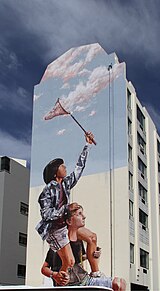
Dunedin pioneered "official" street art in New Zealand with over sixty bus shelters being given unique murals by painter John Noakes during the 1980s, many of them featuring local scenes or scenes inspired by the names of their locales.[121] The Dunedin City Council has since commissioned a series of similar designs to grace electric boxes around the city. Street murals have also become a popular addition to Dunedin, with over 30 works by both local and overseas artists being added to the central city — especially around the Warehouse Precinct and Exchange areas – since an international street art festival was held there in the early 2000s.[122] These include one of New Zealand's tallest works, a seven-story mural on the wall of the Southern Cross Hotel by Fintan Magee.[123]
Christchurch was devastated by 2 earthquakes in 2010 and 2011 and as a result, 8000 homes and 80 percent of the central city were condemned. It wasn't until two and half years later that the city was able to host its first major cultural event[citation needed] - Rise Street Art Festival held at Canterbury Museum produced by Australasian street art organizer Oi YOU!.[124]
The event attracted over 248,000 visitors (the most-visited show in the Museum's history) and saw 15 murals painted across the devastated central city. The murals became community icons for the re-emergence and rebuild of Christchurch.[citation needed]
Two further Oi YOU! Festivals, both under the name of Spectrum, featured large internal exhibitions as well as adding to the city's stock of murals.[125] Since Rise, over 40 murals have been produced in the central city and the Lonely Planet guide to global street art featured Christchurch as one of the best cities in the world to experience the art form.[citation needed]
In Auckland in 2009, Auckland's city council permitted electrical boxes to be used as canvases for street art. Local street art group TMD (The Most Dedicated) won the "Write For Gold" international competition in Germany two years in a row. Surplus Bargains is another local collective.[126] In 2019 in Auckland, a heritage building in the city was painted without the owners' permission by Ares Artifex.[127]
Africa[]
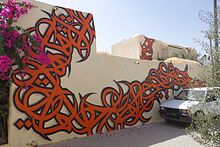
Although street art in South Africa is not as ubiquitous as in European cities, Johannesburg's central Newtown district is a center for street art in the city.[128] The "City Of Gold International Urban Art Festival" was held in the city's Braamfontein civic and student district in April 2012.[129]
The New York Times reported Cairo's emergence as a street art center of the region in 2011. Slogans calling for the overthrow of the Mubarak regime has evolved into æsthetic and politically provocative motifs.[130][131]
Street art from Egypt, Tunisia, Yemen, and Libya has gained notoriety since the Arab Spring, including a 2012 exhibition in Madrid's Casa Árabe.[132]
Exhibitions, festivals, and conferences[]
In 1981, Washington Project for the Arts held an exhibition entitled Street Works, which included urban art pioneers such as Fab Five Freddy and Lee Quiñones working directly on the streets.[133]
Sarasota Chalk Festival was founded in 2007 sponsoring street art by artists initially invited from throughout the US and soon extended to internationally. In 2011 the festival introduced a Going Vertical mural program and its Cellograph project to accompany the street drawings that also are created by renowned artists from around the world. Many international films have been produced by and about artists who have participated in the programs, their murals and street drawings, and special events at the festival.[134]
The Street art festival istanbul is Turkey's first annual street art and post-graffiti festival.[135] The Festival was founded by the artist and graphics designer Pertev Emre Tastaban in 2007.[136]
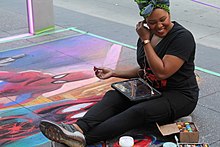
Living Walls is an annual street art conference founded in 2009.[138] In 2010 it was hosted in Atlanta and in 2011 jointly in Atlanta and Albany, New York. Living Walls was also active in promoting street art at Art Basel Miami Beach 2011.[139]
The RVA Street Art Festival is a street art festival in Richmond, Virginia began in 2012. It is organized by Edward Trask and Jon Baliles. In 2012, the festival took place along the Canal Walk; in 2013 it took place at the abandoned GRTC lot on Cary Street.[140]
The Pasadena Chalk Festival, held annually in Pasadena, California, is the largest street-art festival in the world, according to Guinness World Records.[141] The 2010 edition involved about six hundred artists of all ages and skills and attracted more than 100,000 visitors.[142]
[143] launched a comprehensive Street Art exhibition "A Walk Into Street Art"[144] in April 2018. This exhibition in virtual reality offers works from Banksy, JR, Jef Aérosol, Vhils, Shepard Fairey, Keith Haring, etc.
The Eureka Street Art Festival is an annual public art event in Humboldt County, California. Artists from throughout California and the world to paint murals and create street art during a week-long festival. The 2018 festival saw 24 artists create 22 pieces of public art in the Old Town area of the city, focusing on Opera Alley.[145] The 2019 festival is centered on the Downtown region.
Documentary films[]
- Rash (2005), a feature-length documentary by Mutiny Media exploring the cultural value of Australian street art and graffiti
- Bomb It (2008), a documentary film about graffiti and street art around the world
- Exit Through the Gift Shop (2010), a documentary created by the artist Banksy about Thierry Guetta
- Style Wars (1983), a PBS documentary about graffiti artists in New York City featuring Seen, Kase2, Dez and DONDI
- Obey Giant (2017), a documentary about the life and career of street artist, illustrator, graphic designer, activist, and founder of OBEY Clothing, Shepard Fairey.
See also[]
- Father Pat Noise
- Graffiti
- Graffiti terminology
- Graphopoli
- Guerilla art and hacking art (category)
- List of street artists
- Lock On street art
- Mission School
- Public art
- Rock balancing
- Screen-printing
- Brandalism
- Spray paint art
- Stencil
- Street installation
- Street poster art
- Yarn bombing
- Craftivism
References[]
- ^ https://www.nytimes.com Aerosol Art ("...in favor of the catchall 'Independent Public Art'").
- ^ http://www.filippominelli.com Filippo Minelli "Silence/Shapes."
- ^ Antonova, Maria. 2014. "Street Art." Russian Life 57(5):17
- ^ "Student art project is vandalism for a cause". The Herald-Times. Archived from the original on 20 March 2012. Retrieved 4 April 2011.
- ^ For the development of style in the aerosol paint medium, as well as an examination of the political, cultural, and social commentary of its artists, see the anthropological history of New York subway graffiti art, Getting Up: Subway Graffiti in New York, by Craig Castleman, a student of Margaret Mead, The MIT Press, Cambridge, Massachusetts, 1982.
- ^ Geek Graffiti: A Study in Computation, Gesture and Graffiti Analysis
- ^ Jump up to: a b Smith, Howard (21 December 1982). "Apple of Temptation". The Village Voice. Manhattan, New York, US. p. 38.
- ^ Zotti, Ed (4 August 2000). "What's the origin of 'Kilroy was here'?". Straight Dope; staff report from the Science Advisory Board. Sun-Times Media, LLC. Retrieved 29 October 2016.
- ^ Robinson, David (1990) Soho Walls – Beyond Graffiti, Thames & Hudson, NY, ISBN 978-0-500-27602-0
- ^ Drasher, Katherine (30 June 1983). "Avant's on the Street". The Villager. pp. 31–32. Retrieved 29 August 2009.
- ^ Jump up to: a b Zox-Weaver, Annalisa (1 June 2015). "Institutional Guerilla Art Open Access: The Public Sculpture of Florentijn Hofman". Sculpture Review. 3 (22–26).
- ^ Tierney, John (6 November 1990). "A Wall in SoHo; Enter 2 Artists, Feuding". The New York Times. ISSN 0362-4331. OCLC 1645522. Retrieved 4 May 2012.
- ^ Jump up to: a b Strausbaugh, John (5–11 April 1995). "Reneissance Man". New York Press. 8 (14). p. Cover, 15, 16. ISSN 0362-4331. OCLC 1645522.
- ^ "Moncada v. Rubin-Spangle Gallery, Inc. – November 4, 1993". Leagle.com. 4 November 1993. Retrieved 29 April 2012.
- ^ Landes, William M.; Posner, Richard A. (2003). The Economic Structure of Intellectual Property Law (illustrated ed.). Cambridge, Massachusetts, US: Harvard University Press. p. 285. ISBN 978-0-674-01204-2. OCLC 52208762. Retrieved 4 May 2012.
- ^ Ginsburgh, Victor; Throsby, C. D. (13 November 2006). Handbook of the Economics of Art and Culture (illustrated, reprint ed.). Amsterdam, Netherlands: Elsevier. p. 231. ISBN 978-0-444-50870-6. OCLC 774660408. Retrieved 4 May 2012.
- ^ Lerner, Ralph E.; Bresler, Judith (2005). Art law: the guide for collectors, investors, dealers, and artists (3rd ed.). New York City, New York, US: Practising Law Institute. ISBN 978-1-4024-0650-8. OCLC 62207673. Retrieved 4 May 2012.
- ^ Kostelanetz, Richard (2003). SoHo; The Rise and Fall of an Artist's Colony (1st ed.). New York, NY: Routledge. pp. 102–104. ISBN 978-0-415-96572-9. Retrieved 29 October 2016.
- ^ Kahn, Steve (1999). SoHo New York. New York, NY: Rizzoli International Publications, Inc. p. 65. ISBN 978-0-8478-2156-3.
- ^ I AM THE BEST ARTIST Rene mural (1987). The Secret of My Success (Comedy film). US: Universal Studios.
- ^ Glassman, Carl (1985). SoHo; A Picture Portrait. New York, NY: Universe Books. pp. TK. ISBN 978-0-87663-566-7.
- ^ "Incredible street art tours". Retrieved 26 February 2015.
- ^ Means, Gary. "Alternative London Street Art Guides". alternativeldn.com. Retrieved 26 February 2015.
- ^ "Paris Underground". undergroundparis.org. Retrieved 26 February 2015.
- ^ "Alternative Berlin". alternativeberlin.com. Retrieved 26 February 2015.
- ^ Bross, F. (2017): Beer Prices Correlate with the Quality of Illegal Urban Art. A Case Study on the Relationship Between Street Art and Gentrification in a Berlin Neighborhood. Mimeo.
- ^ Salib, Peter (Fall 2015). "The Law of Banksy: Who Owns Street Art?". University of Chicago Law Review. 82 (4): 293. SSRN 2711789.
- ^ 17 U.S.C. § 102
- ^ 17 U.S. Code § 302
- ^ 17 U.S. Code § 201
- ^ "moral, adj.". OED Online. September 2011. Oxford University Press. 25 October 2011.
- ^ H&M Lawsuit Against Street Artist Could Change Copyright Law. (2018). Hyperallergic. Retrieved 28 April 2019, from https://hyperallergic.com/432709/hm-lawsuit-street-artist-revok-copyright-law/
- ^ Villa, 2003 WL 22922178
- ^ Graffiti Cannot be Copyright Protected, Claims Moschino, Jeremy Scott. (2016). The Fashion Law. Retrieved 29 April 2019, from http://www.thefashionlaw.com/home/graffiti-cannot-be-copyright-protected-claims-moschino-jeremy-scott
- ^ Jump up to: a b Id.
- ^ 17 U.S.C. § 106A
- ^ Unchartered Territory: Enforcing an Artist's Rights in Street Art | HHR Art Law. (2017). HHR Art Law. Retrieved 29 April 2019, from https://www.hhrartlaw.com/2017/01/unchartered-territory-enforcing-an-artists-rights-in-street-art/
- ^ Finn, R. (2014). 5Pointz Arts Center, and Its Graffiti, Is on Borrowed Time. Nytimes.com. Retrieved 29 April 2019, from https://www.nytimes.com/2011/08/28/nyregion/5pointz-arts-center-and-its-graffiti-is-on-borrowed-time.html
- ^ Jump up to: a b c Bloch, Stefano. 2015. "Street Art, Public City: Law, Crime and the Urban Imagination." Urban Studies (Sage Publications, Ltd.) 52(13):2500-2503.
- ^ Campos, Ricardo. 2015. "Youth, Graffiti, and the Aestheticization of Transgression." Social Analysis 59(3):17-40.
- ^ Jump up to: a b c d e f Bacharach, Sondra. 2015. "Street Art and Consent." British Journal of Aesthetics 55(4):481-495
- ^ Jump up to: a b c d e Sisko (Summer 2015). "Guerilla Sculpture: Free Speech and Dissent". Sculpture Review. 64 (2): 26–35.
- ^ "'Hope flows through her': artist Marc Quinn on replacing Colston with a Black Lives Matter statue". the Guardian. 15 July 2020. Retrieved 10 February 2021.
- ^ "Jen Reid: Bristol Black Lives Matter statue removed". BBC News. 16 July 2020. Retrieved 10 February 2021.
- ^ Johnathen Duran, Free Art Friday: A Global Art Movement Everyone Can Appreciate mic.com, 21 March 2013 [retrieved 3 Dec 2016]
- ^ Holly Roberts, Month-long art scavenger hunt, Free Art Movement, comes to Classic City, TheRed&Black, 7 Apr 2016 [retrieved 3 Dec 2016]
- ^ Guetzkow 2002, Joshua. "The World is Our Canvas: Nonprofit Empowers Street Artists to Uplift Neighborhoods" (PDF). Cite journal requires
|journal=(help) - ^ Crouch, Angie. "How the Arts Impact Communities". NBC. NBC Los Angeles.
- ^ Rojo, Jaime; Harrington, Steven P. (2010). Street Art New York. Prestel Pub. ISBN 978-3-7913-4428-7.
- ^ Seth Kugel (9 March 2008) "To the Trained Eye, Museum Pieces Lurk Everywhere", The New York Times
- ^ "History | Mural Arts Program". Muralarts.org. Retrieved 7 July 2012.
- ^ Hoff, Al (14 December 2006). "Best Public Art: Sprout Fund Murals". Pittsburgh City Paper.
- ^ Wheatley, Thomas (5 May 2011). "Atlanta's graffiti task force begins investigating, removing vandalism & Views | Creative Loafing Atlanta". Clatl.com. Retrieved 7 July 2012.
- ^ Morris, Mike (4 October 2011). "Warrants issued for serial graffiti vandals". ajc.com. Archived from the original on 7 January 2012. Retrieved 7 July 2012.
- ^ "City of Atlanta settles lawsuit with street artists | Bill Rankin's Legal Brief". Retrieved 11 February 2018.
- ^ "New website provides street art map to murals all over Atlanta". accessatlanta. Retrieved 5 January 2018.
- ^ Smith, Jessi, Get a ringside seat: MTO is not pulling any punches in his latest mural, This Week in Sarasota, 20 December 2012
- ^ Rojo, Jamie and Harrington, Steven, "Unpremeditated" Movie from Street Artist MTO is a Knock Out, The Huffington Post, 20 March 2013
- ^ Graham, Jefferson (1 June 2018). "Photo tour: Graffiti steals the show in L.A.'s burgeoning Arts District". USA Today. Retrieved 4 December 2019.
- ^ Larson, Nicole (13 May 2011). "PHOTOS: Largest Street Art Collection Debuts At LAB ART LA". The Huffington Post.
- ^ San Francisco Bay Guardian, 18–24 January 2012, p. 22
- ^ Veltman, Chloe (8 May 2010) "Street Art Moves Onto Some New Streets", The New York Times
- ^ "Under Pressure – Annual Graffiti Festival". underpressure.ca. Retrieved 16 January 2021.
- ^ "Toronto Graffiti :: urban artists for hire". Retrieved 29 July 2015.
- ^ https://yycbump.ca/
- ^ "The Unknown, Underrated Street Art of Richmond, Virginia (Photo Essay)". Packs Light. 19 January 2016. Retrieved 11 April 2017.
- ^ "The Best Denver Street Art | VISIT DENVER". www.denver.org. Retrieved 21 April 2017.
- ^ https://www.allcitycanvas.com/en/about
- ^ https://www.allcitycanvas.com/en/bier-en-brood-mural-for-all-city-canvas-new-york
- ^ https://www.allcitycanvas.com/en/vhils-creates-amazing-mural-in-parque-la-ruina-for-all-city-canvas-global-series
- ^ "Colorful mural might be world's longest | Reuters.com". mobile.reuters.com. Retrieved 4 November 2015.
- ^ Romero, Simon (29 January 2012) "At War With São Paulo’s Establishment, Black Paint in Hand", The New York Times
- ^ Scott, Gabe (17 July 2009). "Claudio Ethos". Exclusive Feature. High Speed Productions, Inc. Retrieved 29 October 2016.
- ^ López, A. (17 August 2017) "¿Adios a los murales de La Candelaria?", Cartel Urbano
- ^ "The Banksy Paradox: 7 Sides to the World's Most Infamous Street Artist, 19 July 2007
- ^ "Walking with Stik". Dulwich OnView, UK. 12 June 2012. Retrieved 17 June 2012.
- ^ Beazley, Ingrid (2015). Street Art, Fine Art. London: Heni Publishing. ISBN 978-0-9568738-5-9.
- ^ "Has Banksy struck in Primrose Hill?". BBC News. 11 June 2010.
- ^ "Huge murals on buildings created by artist duo ETAM CRU". NetDost. 16 January 2014. Archived from the original on 20 January 2014.
- ^ "10 Stencil Artists Changing the Way We Look at the City". My Modern Met. 22 May 2017. Retrieved 10 July 2018.
- ^ "Street Art in 13 Arrondissement". Paris Digest. 2018. Retrieved 22 October 2018.
- ^ "IMMENSE SUCCES POUR L'EXPOSITION AVEC 113 228 VISITEURS !" [Great success for the exhibition with 113,228 visitors!] (PDF) (Press release) (in French). Paris: Fondation EDF. 2 March 2015. Retrieved 30 December 2018.
- ^ Barba-Court, Kala (18 May 2018). "John Hamon: The Enigmatic, Enduring Mystery Of Paris". Plain Magazine. Archived from the original on 20 May 2019. Retrieved 20 May 2019.
- ^ Lepores, Domingos (13 September 2017). "Berlin Street Art Museum - Urban Nation Contemporary Urban Art". AWESOME BERLIN. Retrieved 15 January 2020.
- ^ Karsten Kaminski. "Tänavakunst Tartus: rohkem kui ainult kunst" Postimees Kultuur, 26 April 2015 [in Estonian]
- ^ Marika Agu & Sirla. Street art in Tartu, Estonia Vandalog, 8 July 2014
- ^ Donadio, Rachel (14 October 2011). "In Athens art blossoms amid debt crisis". The New York Times. Retrieved 14 October 2011.
- ^ "Street Art, Art Culture Style". Hisour. Retrieved 10 March 2021.
- ^ Stewart, Jessica (1 January 2013). Street Art Stories Roma. Mondo Bizzarro. p. 128. ISBN 978-8896850152.
- ^ 15 Dutch Street Artists you must Known, Street Art Today
- ^ "Dr. Rat, Godfather van de Nederlandse graffiti". Lebowski. Retrieved 5 April 2014.
- ^ Malt, Frank (2014). 100 European graffiti artists. Atglen, Pennsylvania, Schiffer Publisching Ltd.
- ^ Ødegård, Ann Kristin (24 March 2010). "Gatekunstens hovedstad" (in Norwegian). Ba.no. Retrieved 24 March 2010.
- ^ Thorkildsen, Joakim (10 March 2008). "Fikk Banksy-bilder som takk for overnatting" (in Norwegian). Dagbladet.no.
- ^ "Derfor valgte ikke DOLK Bergen" (in Norwegian). Ba.no. 8 September 2011. Retrieved 18 September 2011.
- ^ Bergesen, Guro H. "Populær Dolk selger så det suser" (in Norwegian). Bt.no. Retrieved 21 September 2011.
- ^ "Forsvarer verning av graffiti" (in Norwegian). Ba.no. 26 June 2009. Retrieved 26 June 2009.
- ^ "Bergenkommune.no – Graffiti og gatekunst i kulturbyen Bergen – Utredning og handlingsplan for perioden 2011–2015" (PDF) (in Norwegian). Bergen.kommune.no. Archived from the original (PDF) on 21 July 2013. Retrieved 10 May 2011.
- ^ http://www.nuartrad.no
- ^ Carlsson, Benke (2007). Street art Stockholm. Stockholm: Ström. ISBN 9789171260765.
- ^ Gallery housing mentioned street artists Archived 20 November 2013 at the Wayback Machine
- ^ Billeter, F. (1984). Graffiti : Wandkunst und wilde Bilder. Basel: Birkhäuser. ISBN 978-3-7643-1617-4.
- ^ "Ata Bozaci". Widewalls.
- ^ Eugene (29 September 2011). "Polish City Embraces Street Art – My Modern Metropolis". Mymodernmet.com. Retrieved 7 July 2012.
- ^ "Poland – Street-art and Graffiti". FatCap. Retrieved 7 July 2012.
- ^ Alice Pfeiffer, "Graffiti Art Earns New Respect in Moscow", New York Times, 13 October 2010
- ^ "Street artist 'Russia's answer to Bansky'". BBC. 8 February 2012. Retrieved 21 June 2012.
- ^ Jump up to: a b Documentary film about street art in Tbilisi by KetevanVashagashvili."Gallery in the Street", 17 May 2015 [1] Retrieved on 12 November 2015
- ^ Caucasus Business Week www.cbw.ge "Amazing Street-Art of Georgia", 9 March 2015 [2] Retrieved on 9 November 2015
- ^ Georgia Today. Nina Ioseliani. www.georgiatoday.ge "Street art in Georgia", 20 August 2015 [3] Retrieved on 27 August 2015
- ^ "Beton Fest čini Sarajevo 3D prijestlonicom svijeta". N1 Television.
- ^ "3D street art on Peace in Sarajevo". verabugatti.it.
- ^ "Cijelo Sarajevo pozvano na Beton Fest". klix.ba.
- ^ "3D street painting festival in Sarajevo". cuboliquido.com.
- ^ "Sarajevo: Još samo pet dana do četvrtog Beton Festa". Radio Sarajevo.
- ^ Asia's Tallest Mural in South Korea by Hendrik Beikirch
- ^ "Asia's tallest mural – By Hendrik Beikirch". 5 September 2012. Retrieved 29 July 2015.
- ^ Winks, Mathias (14 December 2016). ""Curiosity" - New Mural by Street Artist Seth Globepainter in Dubai // UAE". MC Winkels weBlog (in German). Retrieved 15 January 2020.
- ^ McFarlane, Nyree (29 November 2016). "Satwa is currently turning into a huge street art gallery". What's On. Retrieved 15 January 2020.
- ^ "Australian Street Art Towns". Australian Silo Art Trail. 20 May 2021. Retrieved 23 May 2021.
- ^ "Tribute to bus shelter artist unveiled," Otago Daily Times, 17 April 2012. Retrieved 1 December 2018.
- ^ "Artworks," dunedinstreetart.co Retrieved 1 December 2018.
- ^ This was New Zealand's tallest street mural until the creation of a nine-storey mural in Invercargill in 2019.
- ^ "Rise Street Art Christchurch | Oi YOU!".
- ^ "Spectrum Street Art Christchurch 2015".
- ^ Allen, Linlee. (9 November 2009) Linlee Allen, "Street Smart | Auckland’s Art Bandits", The New York Times. Tmagazine.blogs.nytimes.com. Retrieved 2 April 2013.
- ^ Massive mural
- ^ "Report graffiti hotspots", City of Johannesburg site, 28 June 2012 Archived 11 July 2012 at the Wayback Machine
- ^ "South Africa: Hotel, Graffiti Crew Partner to Host Art Festival", AllAfrica.com, 16 April 2012. Allafrica.com (16 April 2012). Retrieved 2 April 2013.
- ^ Wood, Josh (27 July 2011) "The Maturing of Street Art in Cairo", The New York Times.
- ^ "The Best Of Egyptian Political Street Art". Retrieved 4 July 2013.
- ^ Duggan, Grace. (2 February 2012) "Arab Spring Street Art, on View in Madrid", The New York Times.
- ^ Lewisohn, Cedar (2008) Street Art: The Graffiti Revolution, Tate Gallery, London, England, ISBN 978-1-85437-767-8.
- ^ Chalk Festival, a forty-page guide to the 2012 Sarasota Chalk Festival, Sarasota Observer, 28 October through 6 November 2012
- ^ "404 | Go Turkey Tourism".
- ^ http://northeasternuniversityjournalism2011.wordpress.com/2011/07/18/in-istanbul-artists-take-their-ideas-to-the-streets/ Hannah Martin: In Istanbul, artists take their ideas to the streets, 18 July 2011, Retrieved 5 October 2011
- ^ "Amanda Lee Harris". Downtown Minneapolis Street Art Festival. Retrieved 17 August 2019.
- ^ Guzner, Sonia (22 August 2011). "'Living Walls' Speaks Out Through Street Art". The Emory Wheel. Archived from the original on 29 July 2012. Retrieved 9 January 2012.
- ^ "Living Walls". Archived from the original on 10 July 2012. Retrieved 29 July 2015.
- ^ "2013 RVA Street Art Festival to revitalize GRTC property". CBS6. 20 March 2013. Retrieved 22 May 2013.
- ^ Day, Brian (20 June 2015). World's largest chalk art festival draws a crowd in Pasadena. Pasadena Star-News. Retrieved 22 August 2016.
- ^ Day, Brian (20 June 2010). Pasadena Chalk Festival called the world's largest street-art festival. Los Angeles Daily News. Retrieved 22 August 2016.
- ^ "UMA - Universal Museum of Art". Archived from the original on 6 May 2013. Retrieved 6 June 2018.
- ^ "A Walk Into Street Art". Archived from the original on 12 June 2018. Retrieved 6 June 2018.
- ^ Catsos, Jennifer. "Past Festivals". Eureka Street Art Festival.
Further reading[]
- Avramidis, Konstantinos, & Tsilimpounidi, Myrto (Eds.), (2017), "Graffiti and Street Art: Reading, Writing and Representing the City", Routledge, ISBN 978-1472473332
- Bearman, Joshuah (1 October 2008). "Street Cred: Why would Barack Obama invite a graffiti artist with a long rap sheet to launch a guerrilla marketing campaign on his behalf?". Modern Painters. Retrieved 1 October 2008.
- Le Bijoutier (2008), This Means Nothing, Powerhouse Books, ISBN 978-1-57687-417-2
- Bou, Louis (2006), NYC BCN: Street Art Revolution, HarperCollins, ISBN 978-0-06-121004-4
- Bou, Louis (2005), Street Art: Graffiti, stencils, stickers & logos, Instituto Monsa de ediciones, S.A., ISBN 978-84-96429-11-6
- Chaffee, Lyman (1993). Political Protest and Street Art: Popular Tools for Democratization in Hispanic Cultures. Westport, CT: Greenwood Press. ISBN 978-0-313-28808-1.
- Combs, Dave and Holly (2008), PEEL: The Art of the Sticker, Mark Batty Publisher, ISBN 0-9795546-0-8
- Danysz, Magda (2009) From Style Writing to Art, a street art anthology, Dokument Press, ISBN 978-8-888-49352-7
- Fairey, Shepard (2008), Obey: E Pluribus Venom: The Art of Shepard Fairey, Gingko Press, ISBN 978-1-58423-295-7
- Fairey, Shepard (2009), Obey: Supply & Demand, The Art of Shepard Fairey, Gingko Press, ISBN 978-1-58423-349-7
- Gavin, Francesca (2007), Street Renegades: New Underground Art, Laurence King Publishers, ISBN 978-1-85669-529-9
- Goldstein, Jerry (2008), Athens Street Art, Athens: Athens News, ISBN 978-960-89200-6-4
- Harrington, Steven P. and Rojo, Jaime (2008), Brooklyn Street Art, Prestel, ISBN 978-3-7913-3963-4
- Harrington, Steven P. and Rojo, Jaime (2010), Street Art New York, Prestel, ISBN 978-3-7913-4428-7
- Hundertmark, Christian (2005), The Art Of Rebellion: The World Of Street Art, Gingko Press, ISBN 978-1-58423-157-8
- Hundertmark, Christian (2006), The Art Of Rebellion 2: World of Urban Art Activism, Gingko Press, ISBN 978-3-9809909-4-3
- Jakob, Kai (2009), Street Art in Berlin, Jaron, ISBN 978-3-89773-596-5
- Longhi, Samantha (2007), Stencil History X, Association C215, ISBN 978-2-9525682-2-7
- Manco, Tristan (2002), Stencil Graffiti, Thames and Hudson, ISBN 0-500-28342-7
- Manco, Tristan (2004), Street Logos, Thames and Hudson, ISBN 0-500-28469-5
- Marziani, Gianluca (2009), Scala Mercalli: The Creative Earthquake of Italian Street Art, Drago Publishing, ISBN 978-88-88493-42-8
- Palmer, Rod (2008), Street Art Chile, Eight Books, ISBN 978-0-9554322-1-7
- Rasch, Carsten (2014), Street Art: From around the World – stencil graffiti – wheatpasted poster art – sticker art – Volume I, Hamburg, ISBN 978-3-73860-931-8
- Riggle, Nicholas Alden (2010), "Street Art: The Transfiguration of the Commonplaces," Journal of Aesthetics and Art Criticism, Vol. 68, Issue 3 (248–257).
- Robinson, David (1990) Soho Walls – Beyond Graffiti, Thames & Hudson, NY, ISBN 978-0-500-27602-0
- Ross, Jeffrey Ian (Ed.), (2016), "Routledge Handbook of Graffiti and Street Art", Routledge, ISBN 978-1138792937
- Schwartzman, Allan (1985), Street Art, The Dial Press, ISBN 978-0-385-19950-6
- Strike, Christian and Rose, Aaron (August 2005), Beautiful Losers: Contemporary Art and Street Culture, Distributed Art Publishers, ISBN 1-933045-30-2
- Walde, Claudia (2007), Sticker City: Paper Graffiti Art (Street Graphics / Street Art Series), Thames & Hudson, ISBN 978-0-500-28668-5
- Walde, Claudia (2011), Street Fonts – Graffiti Alphabets From Around The World, Thames & Hudson, ISBN 978-0-500-51559-4
- Williams, Sarah Jaye, ed. (2008), Philosophy of Obey (Obey Giant): The Formative Years (1989–2008), Nerve Books UK.
External links[]
 Media related to street art at Wikimedia Commons
Media related to street art at Wikimedia Commons- Street Art at Curlie
- Street Art of Costa Rica, CR - danscape
- Street art
- Culture jamming techniques
- Public art
- Visual arts genres
- Street culture
















